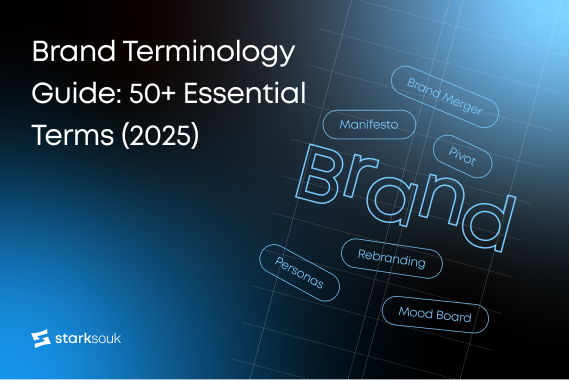Why This Guide Exists
If you’ve ever sat in a meeting with a branding agency and felt lost in jargon, you’re not alone. The branding industry has no standardized terminology. One agency talks about your “brand DNA” while another says “brand fundamentals” or “brand core.” They all mean the same thing.
A designer might present “visual directions” while their colleague calls them “mood boards.” This creates real problems when you’re trying to:
- Communicate with agencies and internal teams
- Make decisions about branding investments
- Evaluate proposals and understand what you’re paying for
- Get stakeholders aligned when everyone interprets terms differently
Why You Need This Knowledge
Understanding brand terminology affects your business success.
For Decision Making: When evaluating a $50,000 rebranding proposal, knowing the difference between a “refresh” and a “complete rebrand” could save you money or prevent under investment.
For Strategic Alignment: If your CMO discusses “brand equity” while your CEO focuses on “brand awareness,” understanding both terms helps bridge the gap and align leadership.
For Agency Collaboration: When an agency presents three “concepts” with “two rounds of revisions,” you’ll know exactly what to expect in deliverables and timelines.
For Competitive Advantage: B2B SaaS founders who understand “product positioning” versus “brand positioning” can more effectively differentiate in crowded markets.
Real World Examples of Terminology Confusion
Here are common scenarios:
- A startup founder thinks “branding” means “designing a logo” and misses the strategic depth of brand positioning and architecture
- A VP of Marketing confuses “brand refresh” with “rebranding,” leading to scope misalignment and budget overruns
- A CEO asks about “brand identity” when they actually need “brand strategy,” resulting in visual work without strategic foundation
- A product team discusses “personas” while marketing refers to “ICPs,” not realizing they’re describing different aspects of the same customers
This guide eliminates that confusion with clear, consistent definitions and practical examples from companies like Apple, Nike, Slack, and Notion.
1. Must Know Terminology: The Foundation
These are the critical terms every business leader should understand. They form the foundation of all branding discussions and decisions.
1. Brand
The overall perception and emotional connection people have with a company, product, or person. It’s not just a logo or name. It’s the sum of all experiences, values, and promises that define how the company is recognized and remembered.
Examples
- Apple is perceived as innovative, premium, and user friendly. This perception influences how people feel about their products before even using them
- When people think of Slack, they associate it with seamless team communication, a playful tone, and productivity
Why it matters Your brand is your most valuable intangible asset. It influences pricing power, customer loyalty, and competitive positioning.
2. Branding
The strategic process of shaping how people perceive your company through deliberate actions, communications, and experiences. It involves creating and managing all touchpoints that influence brand perception.
Examples
- Nike’s branding includes their swoosh logo, “Just Do It” slogan, athlete endorsements, and inspirational marketing campaigns
- Slack’s consistent color palette, friendly tone, and product interface reinforce its positioning as a fun yet professional collaboration tool
Why it matters
Branding is active and intentional. It’s the work you do to shape your brand perception.
3. Personal Branding
The practice of marketing yourself and your career as a brand. It involves defining your unique value proposition, expertise, and personality to stand out professionally.
Examples
- Gary Vaynerchuk built his personal brand around entrepreneurship and hustle culture through consistent content across social media
- A B2B founder who regularly shares SaaS insights on LinkedIn is building a personal brand as a thought leader
Why it matters
In today’s business landscape, founder brands often drive company growth, especially in B2B and startup contexts.
4. Brand Strategy
A comprehensive long term plan that defines how a brand will achieve its business objectives and position itself in the market. It includes positioning, values, voice, and goals. It guides every marketing and design decision.
Key Components
- Target audience definition
- Competitive differentiation
- Brand positioning
- Messaging frameworks
- Growth roadmap
Example
HubSpot’s brand strategy centers around “helping businesses grow better,” which influences its inbound marketing approach and friendly communication style.
Why it matters
Without strategy, you’re just creating pretty visuals. Strategy ensures every branding investment drives business results.
5. Brand Positioning
How you want your brand to be perceived in relation to competitors in the minds of your target audience. It defines your unique place in the market and clarifies what you do, for whom, and why you matter.
Examples
- Volvo positions itself on safety
- Tesla focuses on innovation and sustainability
- BMW emphasizes driving performance
- Notion positions itself as an “all in one workspace” that replaces multiple productivity tools, appealing to startups and creators
Why it matters
Clear positioning helps customers understand why they should choose you over alternatives.
6. Brand DNA / Brand Core / Brand Fundamentals
The essential elements that define what your brand stands for internally. This foundation drives every decision and guides all external brand expressions. It defines what the brand stands for and why it exists beyond profit.
Example
Atlassian’s DNA emphasizes openness, teamwork, and continuous improvement, guiding both culture and product development.
Components
1. Mission
Your brand’s purpose. Why you exist beyond making money. What problem are you solving?
Examples
- Microsoft “To empower every person and every organization on the planet to achieve more”
- Tesla “To accelerate the world’s transition to sustainable energy”
2. Vision
Your aspirational future state. Where you want to be in 5 to 10 years. What change do you want to create?
Example
- Google “To organize the world’s information and make it universally accessible and useful”
3. Values
The core beliefs and principles that guide your brand’s behavior and decision making. They help employees and customers align with the brand’s character.
Examples
- Patagonia’s values include environmental responsibility, quality craftsmanship, and activism. These influence everything from product design to corporate policies
- HubSpot’s HEART values are Humility, Empathy, Adaptability, Remarkableness, Transparency
7. Brand Identity
The visual and verbal expression of a brand. How it looks, feels, and sounds. It includes design, colors, logo, typography, tone, and messaging that together create recognition and consistency.
Example
Stripe’s minimal and modern identity communicates trust, sophistication, and innovation in fintech.
A. Visual Identity
The design elements that visually represent a brand. Logo, color palette, typography, and imagery.
Example
Intercom’s friendly chat bubble logo and vibrant gradients reinforce its human centered SaaS personality.
Components
Logo: A symbol or wordmark that represents the brand visually. It’s a key identifier but only one part of the full identity system.
- Example: Zoom’s simple blue logotype conveys clarity and approachability
- NOTE: Add any of our logos work like – Clifford Automation, Tusker AI
Color Theme/Brand Colors: A consistent set of brand colors used across all visuals to evoke emotions and recognition.
- Example: Slack’s purple communicates creativity and collaboration
Typography/Brand Typography: The font styles and hierarchy used in brand materials to express tone and personality.
- Example: Figma uses clean sans serif typography to reflect simplicity and innovation
Brand and Marketing Collaterals: All branded touchpoints like stationery, decks, brochures, social posts, and website elements that communicate the brand consistently.
- Example: Salesforce’s event materials and web assets all follow one cohesive visual system
Style Guide: Defines how the brand’s design should be used. Covers logo usage, spacing, colors, fonts, and imagery.
- Example: Google’s Material Design guide ensures visual consistency across all products
Brand Guidelines: A comprehensive manual including both visual and verbal rules. Covers tone, mission, values, and usage examples.
- Example: Dropbox’s brand guidelines explain not just how to use the logo, but how to communicate their playful, human tone ( https://brand.dropbox.com/ )
B. Verbal Identity
How a brand speaks and writes. Its tone, language style, and personality. It ensures consistent communication across marketing, support, and internal teams.
Example
Slack’s conversational tone makes users feel like they’re chatting with a colleague, not a software tool.
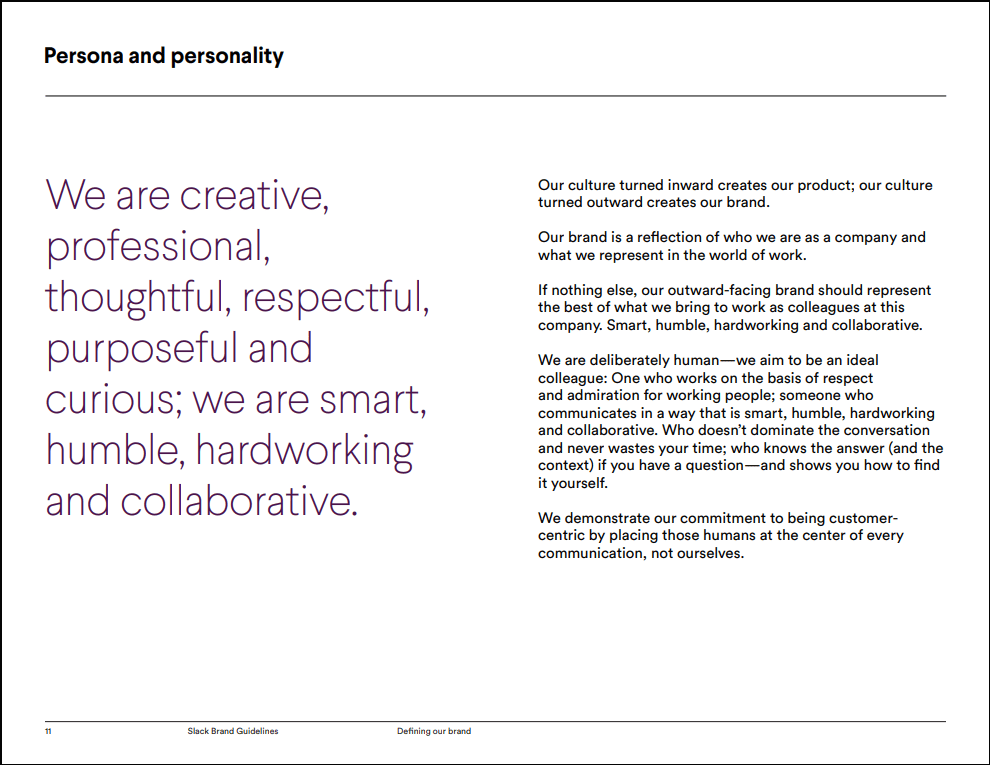
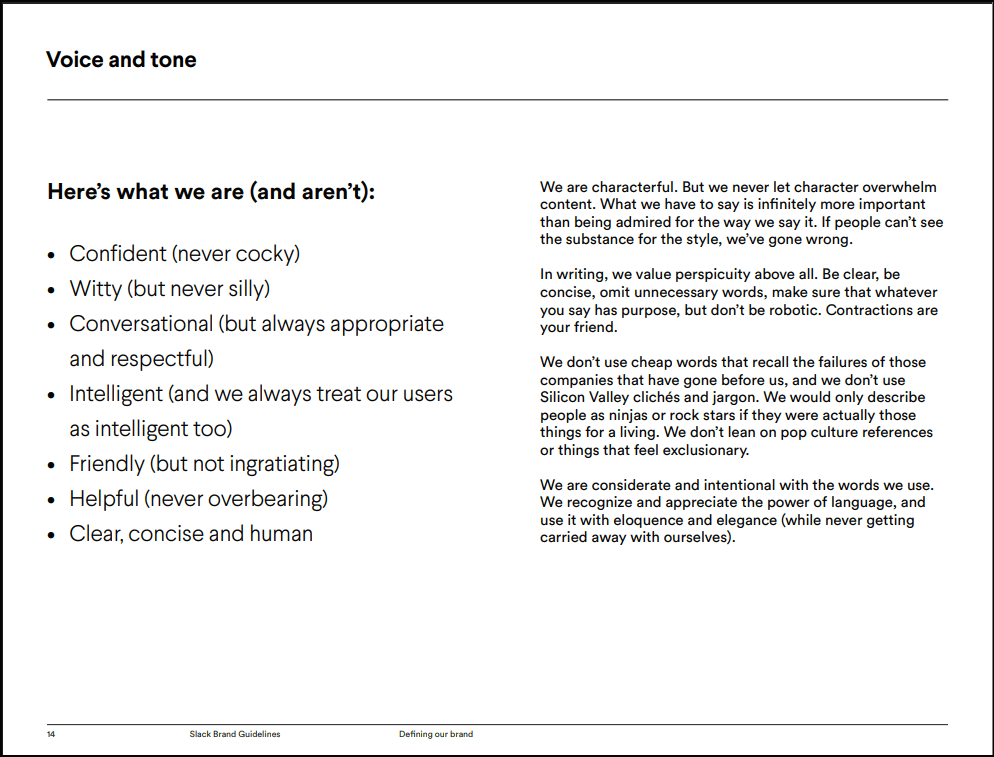
Components
Tone of Voice/Brand Voice: Expresses personality through words. It could be friendly, authoritative, witty, or empathetic.
- Example: Mailchimp’s approachable and witty tone helps make marketing feel fun and easy ( https://styleguide.mailchimp.com/voice-and-tone/ )
Brand Archetype/Brand Personality: A character framework that gives a brand human like traits (Hero, Sage, Creator, etc.). It helps shape tone, visuals, and storytelling.
- Examples: Apple fits the “Creator” archetype (innovative, expressive, design driven). Harley Davidson embodies “The Rebel.” Disney represents “The Magician”
8. Rebranding
A strategic process of changing or repositioning a brand’s identity. Usually involves new visual identity, messaging, or positioning to better align with business goals or market changes.
Examples
- ZoomInfo rebranded to emphasize its evolution from a database tool to an intelligent go to market platform
- Dunkin’ Donuts rebranded to “Dunkin'” to emphasize their beverage offerings beyond donuts
9. Brand Architecture
The organizational structure of brands within a company’s portfolio. It defines the relationship between parent brands, sub brands, and products. It provides clarity for audiences and helps manage brand hierarchy.
Example
Google’s architecture includes parent brand Google and sub brands like Gmail, Drive, and Maps.
Models
- Monolithic Single master brand (like FedEx for all services)
- Endorsed Sub brands endorsed by parent (like Courtyard by Marriott)
- Pluralistic/House of Brands Independent brands (like P&G owns Tide, Gillette, Pampers)
Why it matters
The right architecture prevents brand confusion and maximizes equity across your portfolio.
10. Brand Equity
The commercial value and competitive advantage derived from consumer perception, recognition, and loyalty to your brand. High equity leads to trust, advocacy, and premium pricing.
Examples
- People pay more for a MacBook than comparable laptops because of Apple’s brand equity
- Salesforce’s strong reputation for reliability gives it high brand equity in the SaaS space
Why it matters
Brand equity is a measurable business asset that affects valuation and pricing power.
11. Brand Storytelling
Using narrative techniques to communicate your brand’s purpose, values, and customer benefits in emotionally engaging ways. Makes it relatable and memorable.
Examples
- Airbnb tells stories of hosts and travelers to emphasize belonging and authentic experiences over transactions
- Notion’s community stories highlight real users building workflows, reinforcing its creative, empowering image
Why it matters
People remember stories better than facts. Storytelling creates emotional connections that drive loyalty.
12. Pivot
A fundamental change in business model or target market that requires corresponding brand strategy adjustments. Redefining product, audience, or positioning to better fit the market.
Examples
- Twitter started as a podcasting platform (Odeo) before pivoting to microblogging
- Slack pivoted from a gaming company’s internal chat tool to a full SaaS communication platform
Why it matters
Successful pivots require brand strategy changes. Your old positioning won’t work for your new direction.
13. Brand Merger / Brand Acquisition
When two brands combine (merger) or one acquires another (acquisition). Requires strategic decisions about which brand(s) to maintain, blend, or retire. The branding strategy ensures continuity, clarity, and cultural alignment.
Examples
- After Salesforce acquired Slack, the visual integration reflected unity under Salesforce’s ecosystem while keeping Slack’s identity distinct
- Facebook acquired Instagram but maintained it as a separate brand within their portfolio
14. Employer Branding
How your company is perceived as an employer. Influences your ability to attract and retain talent. It communicates culture, mission, and benefits to potential and current employees.
Examples
- Google’s employer brand emphasizes innovation, perks, and impactful work, making them a top employer destination
- HubSpot promotes its remote first culture and learning opportunities as part of its employer brand
Why it matters
Strong employer branding reduces recruitment costs and improves talent quality.
15. Brand Scale up
Expanding a brand’s presence, operations, and market reach while maintaining brand consistency and values.
16. Brand Creation
Building a new brand from scratch. Includes naming, positioning, identity development, and launch strategy.
17. Turn Around
Revitalizing a declining brand through strategic repositioning, product improvements, or marketing innovations.
Example
LEGO recovered from near bankruptcy by refocusing on core products and expanding into movies and games.
18. Expansion
Growing into new markets, categories, or audiences while extending your existing brand equity.
19. Refresh
A lighter update to modernize a brand’s look and feel without fundamentally changing its core identity or positioning.
Example
Instagram’s logo evolution from skeuomorphic camera to minimalist gradient icon.
20. Brand Restructure
Reorganizing your brand portfolio, architecture, or strategy to improve clarity, efficiency, or market alignment.
21. Brand Experience
Every interaction a customer has with your brand across all touchpoints. From website visits and customer service to product usage and unboxing. Every touchpoint shapes perception and loyalty.
Examples
- Disney creates consistent magical experiences from their parks to movies to merchandise, reinforcing their brand promise
- From onboarding to customer support, Intercom ensures a consistent and human brand experience
2. Agency World Terminology: When Working with Branding Professionals
These are terms you’ll encounter when collaborating with branding agencies, consultants, and creative professionals.
1. Discovery / Brand Discovery
The initial research and exploration phase where insights are gathered about market, customers, competitors, and internal capabilities to inform brand strategy.
Activities Include
- Stakeholder interviews
- Customer surveys
- Market analysis
- Competitive audits
- Identifying brand opportunities
Example
During discovery, an agency might conduct stakeholder interviews and market research for a B2B SaaS startup to understand its positioning and differentiation.
Why it matters
Discovery prevents expensive mistakes. Without it, agencies are designing in the dark.
2. Brand Audit
A systematic examination of a brand’s current position in the market. It evaluates strengths, weaknesses, and performance against competitors. Identifies opportunities for improvement.
What’s Assessed
- Brand awareness
- Customer perception
- Visual consistency
- Messaging effectiveness
- Market positioning
A brand audit for a SaaS firm may reveal that while the product is strong, inconsistent visual branding hurts trust and perception.
3. Mood Board / Visual Directions
A curated visual collage that sets the tone, color palette, typography, and imagery direction for the brand’s aesthetic. It helps align on visual style and emotional tone before investing in final design work.
Why it matters
Mood boards prevent costly misalignment between client expectations and agency execution.
EXAMPLE:
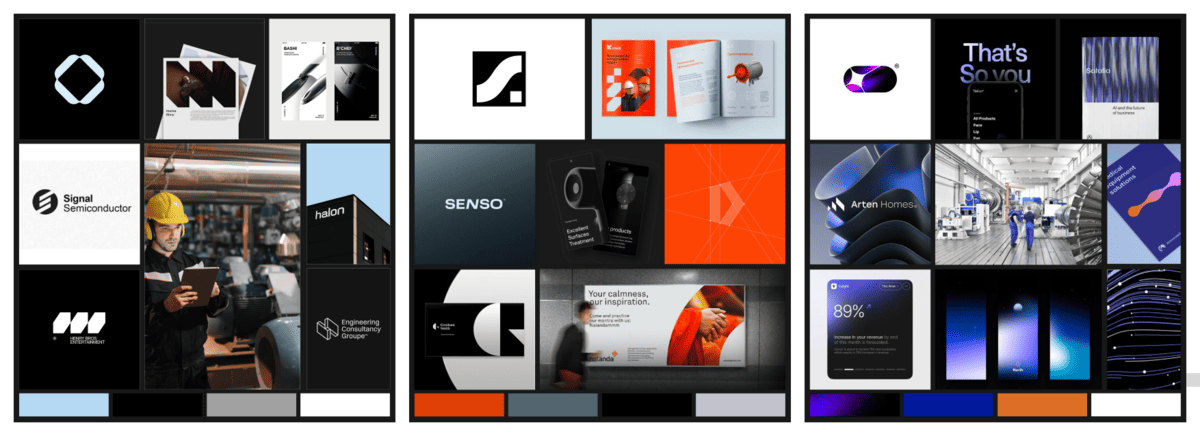
4. Concepts
Creative directions or design ideas presented to show potential visual or strategic paths for the brand.
5. Revisions
Iterative rounds of feedback and improvements on design or content until the final output aligns with the client’s vision and brand strategy. Typically with agreed upon limits (like “3 rounds of revisions included”).
Best Practice: Consolidate feedback to make revision rounds efficient and productive.
Why it matters
Understanding revision limits prevents scope creep and manages expectations.
6. Personas / Target Audience / Buyer Persona
Detailed, semi fictional representations of your ideal customers based on research. Includes demographics, behaviors, motivations, and pain points. Built from data to help shape brand messaging and positioning.
Examples
- “Sarah, 35, Marketing Director at mid size companies, struggles with disconnected marketing tools, values efficiency and ROI”
- For a SaaS company “Growth focused Marketing Director at a Series A startup, aged 32 to 40, seeking scalable automation tools”
7. Qualitative Research
Exploratory research gathering in depth insights through interviews, focus groups, and observations to understand the “why” behind customer perceptions. Their motivations and feelings.
Methods
- One on one interviews
- Focus groups
- Ethnographic studies
- Diary studies
Example
Conducting founder and user interviews to uncover how customers emotionally connect to a SaaS platform’s value.
8. Quantitative Research
Statistical research using surveys and data analysis to measure behaviors, preferences, and trends across larger sample sizes. Uses measurable data to validate brand insights or test assumptions at scale.
Methods
- Online surveys
- A/B testing
- Analytics data
- Market sizing studies
Example
Running a survey among 500 SaaS users to quantify satisfaction with onboarding experience or brand perception.
9. Competition / Competitive Analysis
Systematic evaluation of competitor brands, strategies, strengths, weaknesses, and market positions. Understanding competitors helps position the brand uniquely in the market.
Example
For a CRM startup, competitors may include HubSpot, Pipedrive, and Zoho. Each has distinct branding strategies.
10. Creative Brief
A concise document outlining the project’s goals, audience, deliverables, and creative direction. It ensures alignment between client and agency before execution begins.
Contents
- Objectives
- Audience
- Message
- Tone
- Deliverables
- Success metrics
Example
Before rebranding a B2B SaaS tool, an agency creates a creative brief that defines objectives, tone, and visual mood to guide design decisions.
11. Brand Brief
A comprehensive document detailing all brand strategy, positioning, and identity requirements for a branding project.
Contents
- Business context
- Strategic objectives
- Target audiences
- Competitive landscape
- Success metrics
- Timeline
- Budget
3. B2B SaaS and Tech Startup Terminology
Specialized terminology used in the tech startup and B2B SaaS space.
1. PMF / Product Market Fit
The degree to which your product satisfies strong market demand. When customers clearly understand its value, use it regularly, and would miss it if it disappeared. It’s a key milestone before scaling.
Indicator: when customers are actively seeking your product, paying for it, and recommending it without extensive convincing.
Example: slack achieved PMF when teams organically adopted it as their default communication tool, reducing internal emails dramatically.
Why it matters: Investing in brand before PMF can waste resources. After PMF, branding accelerates growth.
2. ICPs / Ideal Customer Profiles
Detailed descriptions of the companies or individuals most likely to benefit from and purchase your products, especially in B2B contexts.
B2B Example “Series B SaaS companies with 50 to 200 employees, $10M to $50M ARR, experiencing scaling challenges with customer support.”
Why it matters: ICPs are more company focused than personas, which are individual focused. Both are important for B2B.
3. Product Positioning
How your specific SaaS product stands out in the market. What it does best, who it serves, and why it’s different from competitors.
Example
Airtable positions itself as “the flexible database anyone can use,” bridging spreadsheets and professional apps in one platform.
4. Product Messaging
Communicates your product’s value clearly to customers through taglines, headlines, and key statements. It connects product features to customer pain points and benefits, tailored to different audiences.
Example
Notion’s messaging “One workspace. Every team.” instantly explains its all in one productivity focus.
5. Use Cases
Specific scenarios or applications demonstrating how customers use your product to solve problems or achieve goals.
Example
Marketing teams use our tool to automate campaign reporting, saving 10 hours per week and improving executive visibility.
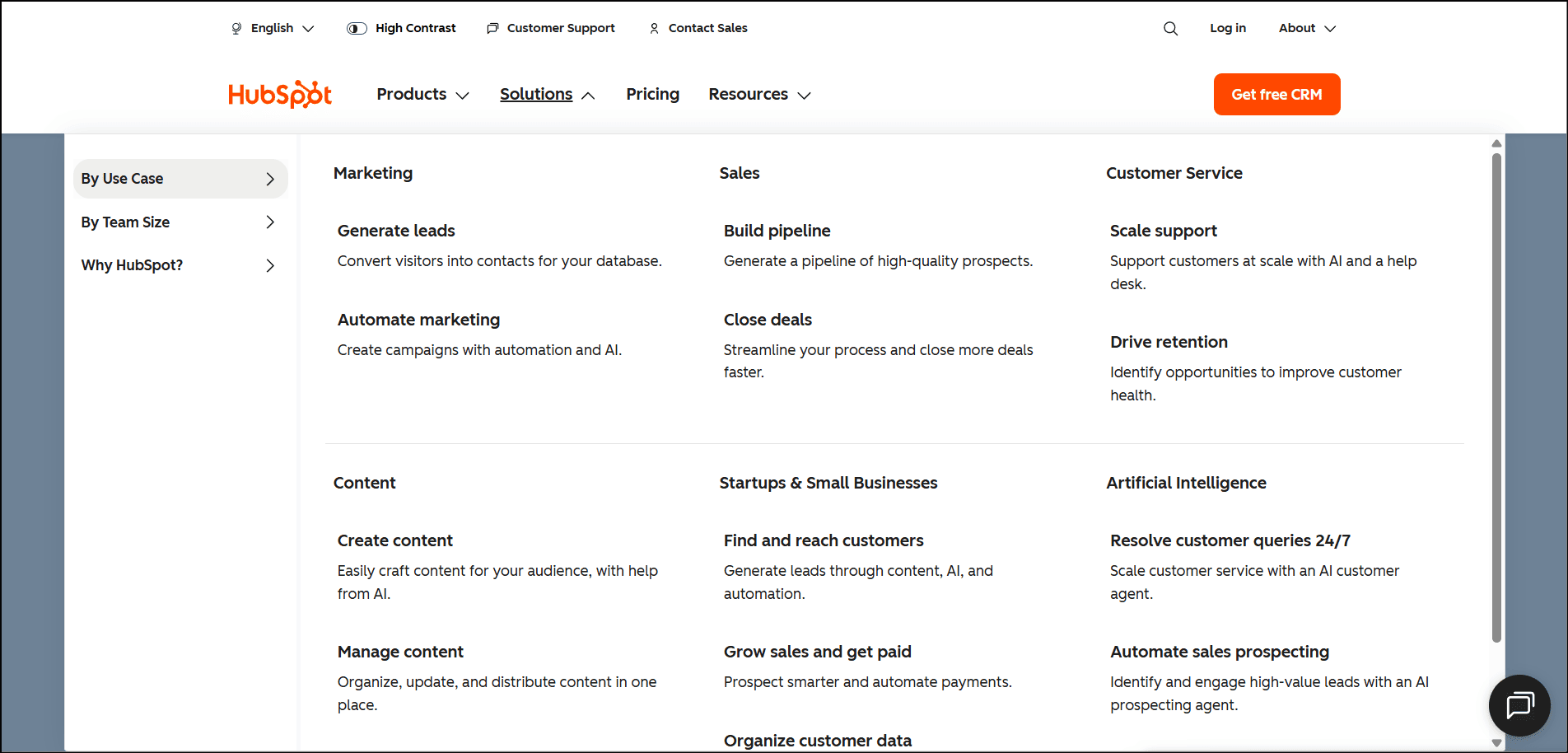
6. Pitch Deck
A visual presentation that communicates a company’s story, problem solution fit, traction, and vision. Often used for fundraising or sales.
7. GTM Strategy / Go To Market Strategy
Your plan for launching a product and reaching customers. Defines how a company will reach its ideal customers and gain competitive traction. Includes audience targeting, channels, pricing, messaging, and positioning.
Components
- Target segments
- Value proposition
- Pricing strategy
- Sales model
- Marketing channels
- Success metrics
Example
HubSpot’s GTM strategy combined free tools (lead magnets) with inbound content marketing to build brand trust before conversion.
4. Advanced Terminology (Good to Know)
Advanced concepts that deepen your branding expertise.
1. Brand Activation
Marketing campaigns or experiences that bring your brand to life and encourage customer engagement and action through direct audience interaction. The goal is to create emotional connection and brand recall.
Example
Red Bull’s extreme sports events activate their “gives you wings” positioning through immersive experiences.
2. Brand Asset
Any brand owned intellectual property that has value. Includes logos, trademarks, color schemes, characters, or proprietary designs. Any element that identifies and differentiates a brand.
Examples
- The Coca Cola bottle shape is a protected brand asset
- Mailchimp’s “Freddie the Chimp” mascot represents its friendly and creative tone
3. Brand Essence
The single most compelling aspect of your brand distilled into a word or short phrase capturing its heart and soul. The core emotional truth that defines the brand.
Examples
- Zoom “Seamless human connection”
- Disney “Magical experiences”
- Volvo “Safety”
- Nike “Athletic achievement”
4. Co branding
A partnership between two brands to create a combined offering or joint campaign that leverages both brands’ equity and benefits both parties.
Examples
- Slack and Atlassian’s integration campaign showcased collaboration between tools, reinforcing both brands’ value in productivity

- GoPro and Red Bull co marketing adventure sports content and events
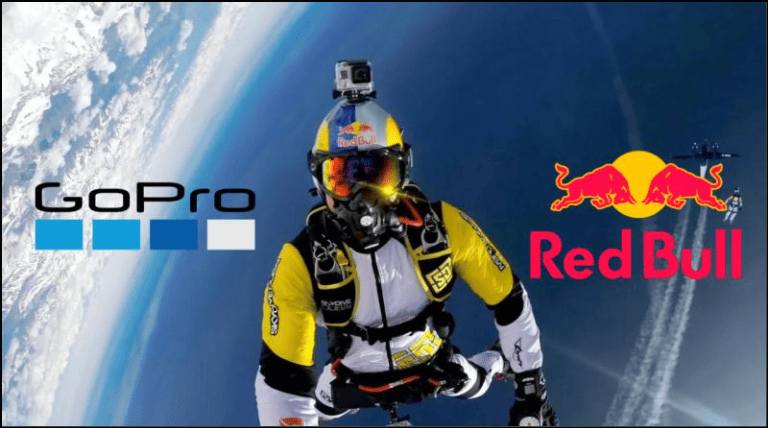
5. Tagline
A short, memorable phrase that captures the essence or promise of the brand and encapsulates your brand positioning.
Examples
- Nike “Just Do It”
- Apple “Think Different”
- HubSpot “Grow Better”
- L’Oréal “Because You’re Worth It”
6. Branding Agency
A specialized firm that provides strategic and creative branding services. Builds and evolves brands through strategy, design, and communication. Aligns business goals with emotional impact.
Services
- Brand strategy
- Naming
- Visual identity design
- Brand guidelines
- Messaging frameworks
- Brand launches
- Website design and development
7. Environmental Branding
Applying your brand identity to physical spaces like offices, retail stores, event venues, or event booths to create immersive brand experiences.
Examples
- Salesforce’s “Dreamforce” events reflect its brand personality through immersive, themed spaces and visuals
- Apple store design with minimalist aesthetic, wood tables, and genius bars reflecting brand values
8. Interior Branding
Integrating brand identity into the physical workspace. Designing interior spaces with colors, signage, and visuals that reflect and reinforce brand identity, culture, and company values.
Purpose: creates immersive brand experiences for employees and visitors, strengthening brand culture.
Example
Figma’s office interiors mirror its brand (open, creative, and collaborative).
9. Ethnography
A research method where brands study customer behavior in real environments to understand their daily habits, motivations, and pain points. Observational research in natural contexts.
Application
Observing how customers actually use products in real life to inform brand and product strategy.
10. Manifesto
A passionate declaration of what a brand believes in, stands for, and strives to achieve. Your brand’s beliefs, purpose, and stance that inspires both internal teams and customers. It goes beyond mission. It’s a rallying cry.
Examples
- Nike “If you have a body, you are an athlete”
- Apple’s “Think Different” manifesto celebrates creativity and innovation, shaping its entire brand ethos
11. Storyboard
A visual sequence that maps out the flow of a story. Often used in video or brand storytelling to align visuals with narrative. Shows how a brand story, campaign, or video will unfold frame by frame.
Use: Planning video content, campaign narratives, or customer journey visualizations.
Example: A SaaS brand’s product video storyboard might show user pain points, solution moments, and success outcomes.
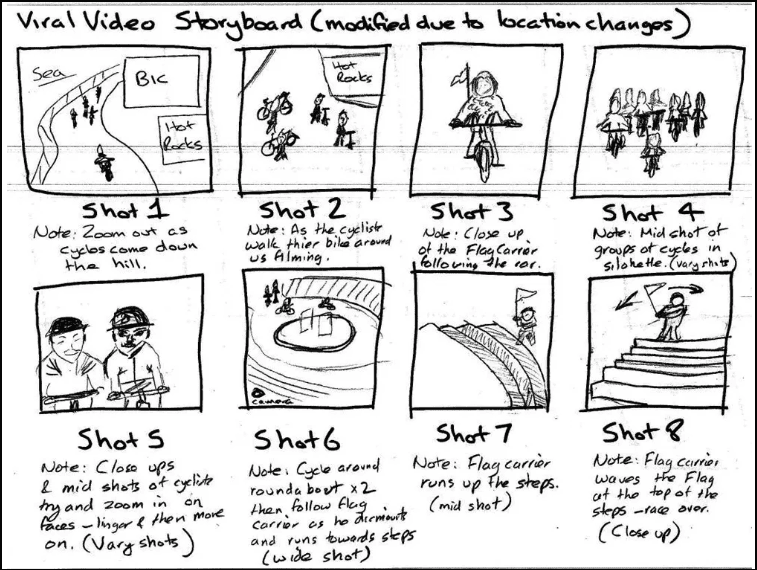
https://medium.com/@yarsky/a-review-of-ideos-storyboarding-technique-36723847f4dc
12. Brand Reputation Management
Actively monitoring and influencing how your brand is discussed and perceived, especially online and in media. Through reviews, PR, social media, and content.
Actions
- Responding to reviews
- Managing crises
- Building positive sentiment
- Addressing negative feedback promptly
13. Brand Marketing
Marketing activities focused on building brand awareness, perception, and emotional connection rather than immediate sales. It builds awareness and long term loyalty by communicating a company’s values and story.
Contrast: Brand marketing builds long term equity. Performance marketing drives short term conversions.
Example
Notion’s brand marketing focuses on empowering creators and teams, not just its features as a productivity app.
14. Challenger Brand
A brand that disrupts the market by challenging category leaders with innovative positioning or approaches. Offering a bold, disruptive, or more customer centric alternative.
Examples
- Webflow positions itself as a challenger to traditional web development by empowering non coders to create powerful websites visually
- Dollar Shave Club challenged Gillette with a direct to consumer model and irreverent marketing
15. Brand Attributes
The characteristics and qualities associated with your brand that differentiate it from competitors.
Example
Amazon’s attributes include convenience, selection, reliability, and customer centricity.
16. Brand Harmonization
Aligning multiple brands or regional variations under consistent guidelines while respecting local nuances.
Example
Unilever standardizing packaging design across markets while adapting to local languages and preferences.
Conclusion
This guide covers over 50+ essential brand terminology terms, but the branding world keeps evolving. New methodologies emerge. Agencies coin their own terminology. Industries develop specialized language.
There’s no single “right” way to talk about branding. What matters is that you and your team, agency partners, and stakeholders align on what these terms mean in your context. When someone introduces a new term, ask for clarification. When you use industry jargon, make sure everyone’s on the same page.
Key Takeaways
- Start with the fundamentals. Master the “Must Know” terms before moving to advanced concepts.
- Context matters. The same term might mean slightly different things in B2B SaaS versus consumer brands.
- Ask questions. Professional agencies welcome clarification. It leads to better outcomes.
- Share this guide. Align your team around common terminology to improve collaboration.
- Keep learning. Branding evolves with culture, technology, and consumer behavior.
Whether you’re a startup founder preparing for your first rebrand, a marketing leader evaluating agency proposals, or a business executive making strategic brand decisions, this terminology foundation will help you navigate the branding world with confidence.
Everyone finds their own way to communicate in this industry. There’s nothing wrong with that. The goal isn’t perfect terminology. It’s clear communication that drives business results.
Related Articles You Might Find Helpful
How to choose the right branding agency for your startup Learn what to look for when evaluating agency partners, red flags to avoid, and questions to ask before signing a contract.
